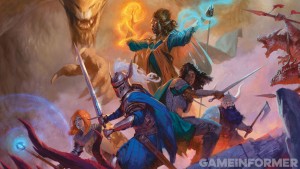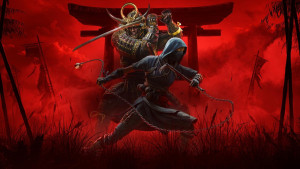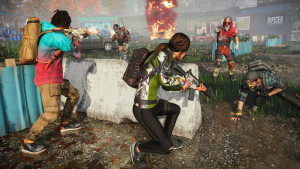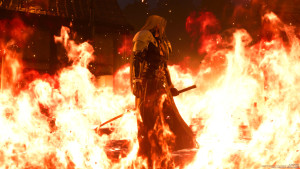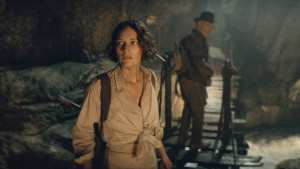Please support Game Informer. Print magazine subscriptions are less than $2 per issue
Bat Outta Hell – The Batman Game You Didn’t Know Existed

Batman has risen to become one of the biggest properties in gaming, but the hero’s next big outing isn’t Rocksteady’s highly anticipated Arkham Knight; it’s a little-known title simply called Batman. However, this game is far from what you’d expect – it’s a car combat title that can only be played in arcades. How did the world’s most popular super hero end up racing into a market that many believe died decades ago? That’s a question befitting the world’s greatest detective.
Street Justice
Gotham’s lunatics are out in full force. Roving gangs led by villains such as The Joker, Bane, and Mr. Freeze have turned Gotham’s streets into a demolition derby. Thankfully, they’re not the only freaks on the road tonight – the Batmobile practically flies off a ramp and out of the Batcave, and within seconds Batman is battling the world’s worst thugs.
Scarecrow has scattered fear toxin across the city and Batman has to race around Gotham to disable his fearsome traps. Fortunately, a series of weapon upgrades and side-mounted machine guns have turned the Batmobile into a tank – a tank that drives like a sports car. Electronic Batarangs let Batman disable enemy vehicles, while sky drones grab cars and fling them off the road, and a battering ram upgrade turns the Batmobile itself into a bullet that smashes anything it touches off the road.
After Batman works his way through a series of missions scattered around the city, he comes face-to-face with the Clown Prince of Crime himself. The Joker has commandeered a freight train and strapped a nuke to it, and Batman has to take out the railcars to shorten the train before he can get to Joker and stop him from nuking the city.
Specular Interactive’s new Batman game features enough explosive action to fill a Call of Duty title, but retains a racy feel similar to EA’s Need For Speed series. Released last November, Specular says that it’s been the most successful arcade game in the last decade. And yet, many gamers haven’t heard of it. Specular’s Batman is an enigma worthy of the Riddler himself. So, how did such an unusual project come to fruition? Its foundations were laid decades ago in the garage of a young boy named Steven Ranck.

A lineup of all the Batmobiles in the game
Before The Bat
Steven Ranck always knew he wanted to make games. “I have very vivid memories of being 13 years old and making these electronic mechanical games as a hobby,” recalls Ranck. “I got such a thrill when my friends would come over and play the things I made. My first project was a Star Trek game, and then I made three Star Wars games. I knew right then that this was what I wanted to do with my life.”
Ranck got a degree in electronic engineering, and started working his way up the corporate ladder, eventually earning a position in upper management, but when a friend told him that Midway Games was hiring, he jumped at the chance to apply. Ranck had to take a 50-percent pay cut and endure a 70-minute commute to the office. On his first day on the job, Ranck was surprised to see that some of the ceiling tiles were falling down and he had to share a cubicle with another officemate. But none of that mattered; Ranck got to write software for video games. He was in love.
Throughout Ranck’s career, he worked on projects like an N64 port of Cruis'n USA and the arcade boat racing title Hydro Thunder, which made waves in the arcade scene. He eventually formed his own studio, Swingin' Ape Studios, which created Metal Arms: Glitch in the System for the GameCube, Xbox, and PlayStation 2 and concepted the never-released StarCraft: Ghost for Blizzard Entertainment. Ranck also made a lot of friends, including industry veteran Eugene Jarvis, the creator of classic arcade games such as Defender, Robotron: 2084, and the Cruis'n racing series.

Steven Ranck (left) and Eugene Jarvis (right)
Years later, Jarvis called Ranck and asked him if he wanted to quit his job and come make coin-op games for a living. Ranck’s reply was, “Isn’t the arcade dead?” Still, it didn’t take much convincing before Ranck formed Specular Interactive and began work on a spiritual sequel to Hydro Thunder, a game called H2Overdrive, which still sells to the arcade market even five years after its initial release. Next up was a monster truck-inspired car combat title called Dirty Drivin'.
After making two successful vehicle-based games for arcades, Specular, along with publisher Raw Thrills, was ready to embark on its most ambitious project to date. Given the studio’s history, the duo knew that they wanted to do another car combat game. They asked themselves, “What would be the ultimate car to drive?” That question didn’t take long to answer: the Batmobile.

Batman takes up residence inside Specular's office
Learning To Drive The Batmobile
Batman is one of the highest profile properties in the world. So it’s not surprising that DC Comic and Warner Bros. are careful about what they allow people to do with the character. However, as soon as DC heard about Ranck and Jarvis’ idea for a Batman car combat title, the company was onboard. “They were super supportive and even gave us a lot of Batman concept art, which we were able to use in the game,” says Ranck.
Specular didn’t pitch a car combat game featuring just one Batmobile; they pitched a game that would feature over ten different versions of the iconic car, spanning across the ’66 Batman television show up through the ‘90s animated series and the more recent Christopher Nolan films. Specular even threw in the Batplane from the most recent Dark Knight Rises film in for good measure.
Players would be able to race around an open-world version of Gotham City, taking on missions to stop some of Batman’s most icon archenemies such as The Joker, Mr. Freeze, Bane, The Penguin, Scarecrow, and Catwoman. Arcade-goers could even clean up Gotham’s streets with a friend since the entire game would be co-op (both players’ scores would be tallied at the end of the round and the player with the lowest score would be labeled the sidekick). Returning players would even be able to input a code to access their profile and pick up where they last left off the next time they visited an arcade. Warner Bros. loved the idea, and so – it would turn out – would arcade players.

A shot of Batman publisher Raw Thrills's warehouse in the US
Succeeding In Arcades Today
It’s not as easy to make a high-profile arcade game as it once was. During the heyday of games like Pac-Man and Donkey Kong, it was hard to keep quarters out of arcade cabinets, but now the industry has diminished to such a degree that most gamers rarely explore an arcade.
“We’re certainly past the golden age of arcades,” says Defender creator Eugene Jarvis, “but it’s still a very viable market. It’s a niche market, but once you start looking for arcade games, you realize that they’re still out there, and they’re everywhere. From the big places like Dave & Buster to local bars and bowling alleys, or even ski resorts, cruise ships, and casinos.”
Specular Interactive has no plans to port its Batman title over to consoles, because it feels that the experience is completely unique to the arcade. In fact, Ranck and Jarvis are all too happy making big-brand games for a smaller audience.
“We have a saying in the industry that once you’ve worked in the arcade, you can never have a real job again,” says Jarvis. “It’s too much fun. From a design standpoint you control everything. You get to design the cabinet, the sound system, the interface; you even get to design the chair that players sit in. If you wanted to put a back massager in the back of the cabinet, all right! Every arcade cabinet is different. It’s like a designers dream.”
Similarly, these designers have given Batman fans an arcade game to dream about. They just have to find a ski resort or casino near them that features this unique Batman experience.
Learn more about Rocksteady's Batman: Arkham Knight, by checking out our month's worth of coverage below.


